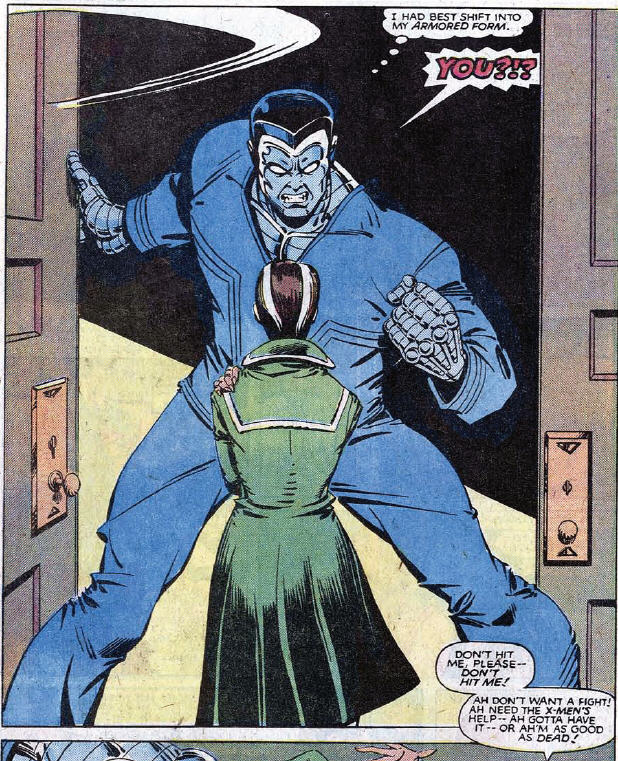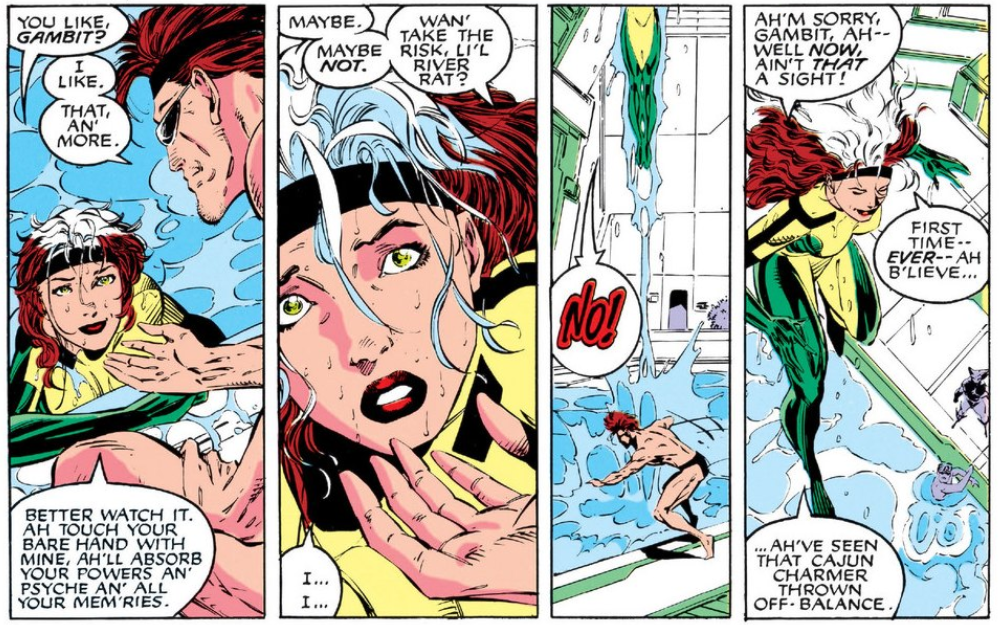Creators: Chris Claremont and Michael Golden
First appearance: Avengers Annual #10 (1981) (Marvel Comics)
Marvel Comics’ mutant Rogue is a long-standing member of the X-Men, and as such, has a convoluted and sometimes contradictory fictional history set in the ongoing soap opera of that superhero team. We do not propose to navigate that particular maze: a read of the Wikipedia entry for the character requires patience and concentration.
Marvel Comics has a long history of reforming villains – Hawkeye, Scarlet Witch, Magneto, and others. Rogue is one of those. She started her existence as the muscle for descriptively named The Brotherhood of Evil Mutants. Rogue’s early appearances as a smirking villain are at odds with her longstanding representation as a beautiful southern belle. On the front cover of The Uncanny X-Men #158, Rogue is depicted punching Wolverine through a steel wall, simultaneously shrugging off lightning bolts manifested by the weather manipulating mutant Storm. Rogue has short hair moulded into devilish fins, and two white stripes flare back from her temples. She is clearly a bad guy. Avengers Annual #10 has Rogue gloating over a defeated Captain America, and if the green eye shadow does not communicate evil, nothing does.

By issue 171 Rogue had joined the X-Men (and more on that later), but writer Chris Claremont continued to play upon readers’ initial dislike and distrust of her – the cover of issue 182 depicted Rogue being shot at while standing over comatose agents of SHIELD (a benevolent espionage agency) and the cover of issue 185 has Rogue triumphantly dragging a comatose Storm by the jacket.
What changed?
In a universe where almost every character has some sort of unique superpower, Rogue was bestowed by Mr Claremont and artist Michael Golden with something quite unique and clever. Rogue could borrow those powers, and even muddle them together to create hybrids. In issue 194 of The Uncanny X-Men, for example, Rogue absorbs the powers of the super strong Russian mutant Colossus, the teleporting German mutant Nightcrawler, and the phasing American mutant Kitty Pride, with devastating effect. The invulnerable robot mutant killer, Nimrod, is shattered by a single blow. But further, Rogue starts thinking in German and Russian.

It is the pinnacle of the suspension of belief required to read superhero comics. As soap operas, superhero comics are otherwise driven by characterisation. And comics are a visual medium, where each character needs to look different, with bright individual costumes so as not to get lost in the crowd. Superpowers are integral to the genre, and here is a character whose ability is to take them for her own: a power that can only exist in a world filled with superpowers. And Rogue can also blur characterisation and muddle visual indicia. There is something a little metaphysical about Rogue.
But in absorbing the skills and powers of others, Rogue also permanently absorbs some of their personalities. These fragments litter her mind. This is especially so in relation to Ms Marvel (much later, known as Captain Marvel), a superhero who Rogue ambushed and almost murdered.

The duration of the contact between the two meant that Rogue permanently absorbed Ms Marvel’s very significant power set. But it lead to a unique fractured personality disorder. Ms Marvel sat within Rogue’s head – an on occasion (such as issue 182) could take over her body.
Suffering from a psychosis triggered by her cowardly attack on Ms Marvel, Rogue seeks help from an enemy – the master telepath and founder of the X-Men, Professor Charles Xavier. Rogue is an important character from that perspective. She was the first character with a mental illness (aside from the “craziness” ascribed to megalomaniac super villains) in American comic books, and certainly the first one to seek professional help for that illness.
Rogue approaches Professor Xavier in an unexpectedly normal way: she knocks on the door. The X-Men are displeased.


And so were readers. From the letters column of The Uncanny X-Men #179 (1981):

Over time, Mr Claremont revealed Rogue to be dependable, incredibly useful in a fight, and even fun. But there was also a pathos, seen best in issue 182. Rogue is in love with a man she does not know, a consequence of absorbing the emotions of Ms Marvel. It is uniquely tragic:

Rogue’s tragedy goes further than stolen emotions. A consequence of absorbing powers and memories of others is that Rogue’s victim is rendered comatose. So much, then for physical intimacy. We then much later meet Rogue’s longstanding paramour and, eventually, husband, Gambit. Gambit is a suave lady’s man.

Mr Claremont introduced some delicious irony into the title by establishing their relationship: the man who can seduced all women with his style and good looks, but cannot so much as touch Rogue without turning into a plank of wood. Sex is not on the cards if you pass out within a second of contact.
Eventually, Rogue loses Ms Marvel’s powers. It was during a period of time where Rogue was powerless that seems to have solidly captured the adoration of fans. Accompanied by SHIELD agents, Rogue is in an time-trapped region called the Savage Land, out to contact sometimes bad guy Magneto.

Dressed in rags and wielding a stone spear, Rogue is plucky. She tried to save some of the agents from being eaten by dinosaurs, forgetting that she has lost her super strength. There is something about Jim Lee’s artistic renditions of Rogue from this issue, such that it is the subject of repeated reproductions as PVC statuettes and cosplay.
Over the many years since 1981, Rogue has been revealed as having a name (Anna-Marie), has had her powers changed (being able to call upon the powers of people she has previously touch at will, like a library; for a time having the power set of the solar powered superhero, Sunfire; and for another while having the powers of the Avengers’ muscle, Wonder Man), and has even led the X-Men. Rogue is now undeniably a fan favourite.

But for us, the example that Rogue sets is one of bravery, to face her mental illness, and to do something about it. Happy 40th Birthday, Rogue.

